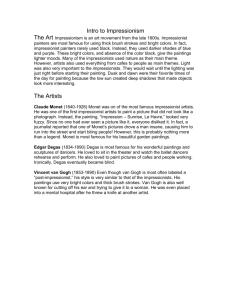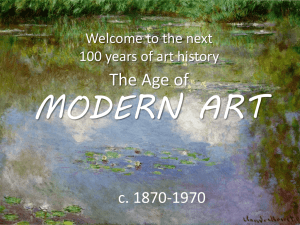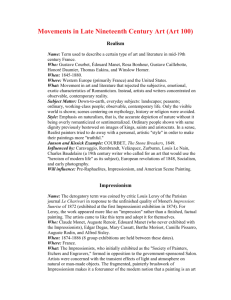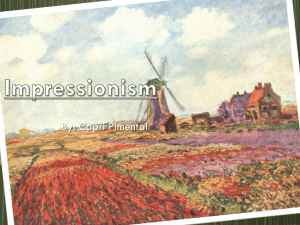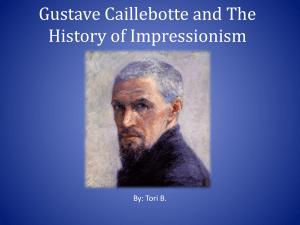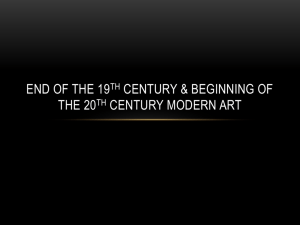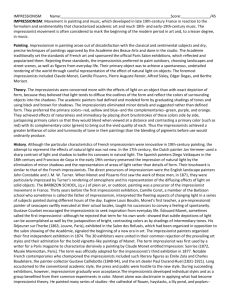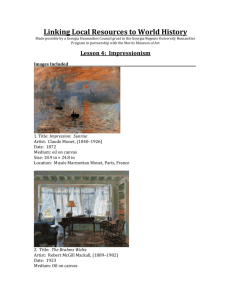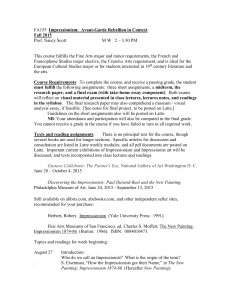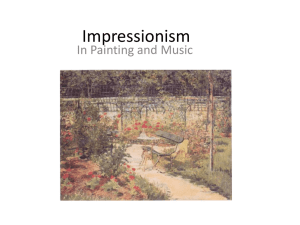Impressionism: Visual Art Lesson Plan for Music Education
advertisement
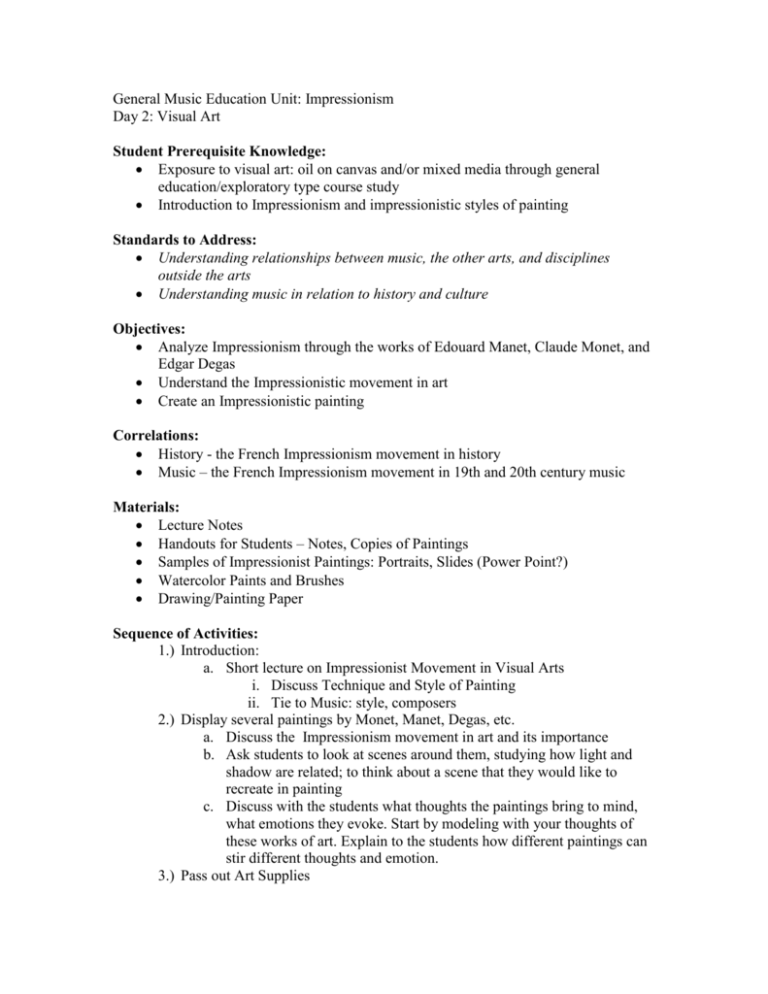
General Music Education Unit: Impressionism Day 2: Visual Art Student Prerequisite Knowledge: Exposure to visual art: oil on canvas and/or mixed media through general education/exploratory type course study Introduction to Impressionism and impressionistic styles of painting Standards to Address: Understanding relationships between music, the other arts, and disciplines outside the arts Understanding music in relation to history and culture Objectives: Analyze Impressionism through the works of Edouard Manet, Claude Monet, and Edgar Degas Understand the Impressionistic movement in art Create an Impressionistic painting Correlations: History - the French Impressionism movement in history Music – the French Impressionism movement in 19th and 20th century music Materials: Lecture Notes Handouts for Students – Notes, Copies of Paintings Samples of Impressionist Paintings: Portraits, Slides (Power Point?) Watercolor Paints and Brushes Drawing/Painting Paper Sequence of Activities: 1.) Introduction: a. Short lecture on Impressionist Movement in Visual Arts i. Discuss Technique and Style of Painting ii. Tie to Music: style, composers 2.) Display several paintings by Monet, Manet, Degas, etc. a. Discuss the Impressionism movement in art and its importance b. Ask students to look at scenes around them, studying how light and shadow are related; to think about a scene that they would like to recreate in painting c. Discuss with the students what thoughts the paintings bring to mind, what emotions they evoke. Start by modeling with your thoughts of these works of art. Explain to the students how different paintings can stir different thoughts and emotion. 3.) Pass out Art Supplies a. Have the students create their own piece of impressionistic artwork using watercolor paints! 4.) Wrap Up Discussion a. Ask students what they think about Impressionism: i. how do the paintings make them feel? ii. do they like this style of artwork? iii. what have they learned? 5.) Assessment a. Students: i. Participation in discussion and class activities 1. Students may turn in the watercolor for credit, or they may choose to keep it. Equal points will be given to all students who have attempted the activity b. Teacher: i. What was successful? ii. Was the content and activities appropriate for the class? iii. How challenging was the lesson? iv. Were the objectives clear? Were they met? I.) Lecture Impressionism was a 19th century art movement that began as a loose association of Paris-based artists who began publicly exhibiting their art in the 1860s. The influence of Impressionist thought spread beyond the art world, leading to Impressionist music and Impressionist literature. A Historical Timeline of Impressionism o The mid 19th century was an atmosphere of change in France as Emperor Napoleon III rebuilt Paris and waged war the Académie des beaux-arts dominated the French art scene Art at the time was considered a conservative enterprise whose innovations fell within the Académie's defined borders The Académie set the standards for French painting Dictated the content of paintings: historical subjects, religious themes, and portraits Commanded which techniques artists used: valued somber, conservative colors, refined images that mirroring reality when closely examined The Académie held an annual art show — Salon de Paris, and artists whose work displayed in the show won prizes and garnered commissions to create more art The young artists painted in a lighter and brighter style than most of the generation before them, extending the realism style of Gustave Courbet and the Barbizon school. A core group of them, Claude Monet, Pierre Auguste Renoir and Alfred Sisley, who had studied under Charles Gleyre, became friends and often painted together o Their pieces were often rejected by the jury panel at the Salon o 1863: Edouard Manet’s Le déjeuner sur l'herbe (Luncheon on the Grass) was sharply rejected by the jury of the Academie becauseit depicted a nude woman with two clothed men on a picnic According to the jury, nudes were acceptable in historical and allegorical paintings, but to show them in common settings was forbidden This set off a firestorm among many French artists!! Although Manet did not consider himself an Impressionist, he led discussions at Café Guerbois where the Impressionists gathered, and influenced the explorations of the artistic group o Napoleon III decreed that the public be allowed to judge the work themselves, and the Salon des Refusés (Salon of the Refused) was organized Critics refused to recognize the organization and harshly rebuked it o 1874: Impressionists (though not yet known by the name) organized their own exhibition o The term impressionism was first and inadvertently coined by Critic Louis Leroy in a satiric review published in Le Charivari. The name of the movement is derived from Claude Monet's Impression, soleil levant (Impression, Sunrise). The term "Impressionists" gained favor with the artists, not as a term of derision, but as a badge of honor. The techniques and standards within the movement varied, but the spirit of rebellion and independence bound the movement together. Impressionist paintings feature short, "broken" brush strokes of pure, untinted and unmixed colour. In most impressionist works, emphasis is on overall effect rather than upon details. The brushstrokes remain visible and part of the composition, as opposed to the then current technique of smoothly modeling without visible brush strokes. Characteristics of Impressionist painting include: o visible brushstrokes o light colors o open composition o emphasis on light in its changing qualities (often accentuating the effects of the passage of time) o ordinary subject matter o unusual visual angles Impressionism became seminal to various movements in painting which would follow, including Post-Impressionism, Fauvism, Cubism and individual painters such as Paul Gauguin, Vincent van Gogh and Paul Cezanne who are loosely described as Impressionists but defy easy categorization. Impressionist Painters: o o o o o o o o o o Jean Beraud Mary Cassatt Gustave Caillebotte Edgar Degas Eva Gonzales Max Liebermann Edouard Manet Claude Monet Pierre Auguste Renoir Auguste Rodin Impressionist techniques Short, thick strokes of paint are used in a sketchy way, allowing the painter to capture and emphasize the essence of the subject rather than its details. Colors are applied with as little pigment mixing as possible, allowing the eye of the viewer to optically mix the colors as they look at the canvas, and providing a vibrant experience for the viewer. Darker shades of a color are made by mixing with complementary colours. (Black was used, but only as a colour in its own right.) They painted wet paint into the wet paint instead of waiting for successive applications to dry, producing softer edges and intermingling of color. Impressionists did not exploit the transparency of thin paint films (glazes) which earlier artists built up carefully to produce effects. The surface of an Impressionist painting is typically opaque. Impressionists discovered or emphasized aspects of the play of natural light, including an acute awareness of how colours reflect from object to object. In outdoor paintings, they boldly painted shadows with the blue of the sky as it reflected onto surfaces, giving a sense of freshness and openness that was not captured in painting previously. (Blue shadows on snow inspired the technique.) They worked "en plein air" (outdoors) Impressionists took advantage of the mid-century introduction of premixed paints in tubes (resembling modern toothpaste tubes) which allowed artists to work more spontaneously both outdoors and indoors. Previously, each painter made his or her own paints by grinding and mixing dry pigment powders with linseed oil. Content and composition Before the Impressionists other painters, such as 17th century Dutch painters like Jan Steen, had focused on common subjects, but according to traditional composition. The Impressionists were also interested in mundane subject matter, but their work differed because of new influences. Photography was gaining popularity, and as cameras became more portable, photographs became more candid. Photography inspired impressionists to capture the moment, not only in the fleeting lights of a landscape, but in the day-to-day lives of people. Another major infuence was Japanese art prints (Japonism), which had originally come into the country as wrapping paper for imported goods. The art of these prints, also contributed significantly to the "snapshot" angles, and unconventional compositions, which are a characteristic of the movement. Edgar Degas' The Dance Class (La classe de danse) shows both influences. A dancer is caught in adjusting her costume, and the lower right quadrant of the picture contains empty floor space. Impressionism in Music II.) The Impressionist movement in music is loosely set between the late 19th century until the mid 20th century Musical Impressionism was based in France (like its precursor in visual art), and the French composers Claude Debussy and Maurice Ravel are generally considered to be the two "great" impressionists o Debussy renounced the term o Ravel composed many other pieces that can't possibly be identified as "Impressionist" o Polish composer Karol Szymanowski o A notable American impressionist composer was Charles Tomlinson Griffes. Philosophically, impressionism aimed to convey the atmospheric impact of an event, place, or thing, rather than an accurate portrayal of the subject itself o Debussy's setting of the Prélude à l'après-midi d'un faune is not a literal portrayal of the events of the already vague poem, but a depiction of the feeling of the poem Impressionist composers also made extensive use of whole tone scales to create a dreamy, "hazy" effect in their works, much like the blurred paintings of Renoir and Monet Works to Display Monet: Impression, Sunrise Dated 1872, but probably created in 1873, its subject is the harbor of Le Havre, using very loose brush strokes that suggest rather than delineate it. Monet explained the title later: "I was asked to give a title for the catalogue; I couldn't very well call it a view of Le Havre. So I said: 'Put Impression.'" It was displayed in 1874 during the first independent art show of the Impressionists (who were not yet known by that name). Critic Louis Leroy, inspired by the painting's name, titled his hostile review of the show in Le Charivari newspaper, "The Exhibition of the Impressionists", thus inadvertantly naming the new art movement. He wrote: Impression — I was certain of it. I was just telling myself that, since I was impressed, there had to be some impression in it … and what freedom, what ease of workmanship! Wallpaper in its embryonic state is more finished than that seascape. The painting was stolen from the Musée Marmottan-Monet in 1985 and recovered in 1990. Since 1991 it has been back on display in the museum. Manet, Luncheon on the Grass Originally titled The Bath (Le Bain), is an oil on canvas painting by Édouard Manet. Painted between 1862 and 1863 it measures 208 by 264.5 cm. The juxtaposition of a female nude with fully dressed men sparked controversy when the work first exhibited at the Salon des Refusés in 1863. The piece is now in the Musée d'Orsay, Paris. Description In the foreground, three characters are seated on the grass: a naked woman and two men dressed like dandies. The woman, whose body is starkly lit, looks frankly in the direction of the viewer. The man on the right wears a flat hat with a tassel. The men seem to be engaged in conversation, ignoring the woman. In front of them, the clothes of the woman, a basket of fruit and a round loaf of bread are displayed as in a still life. In the background, another woman is draped in an almost transparent cloth, bathing in a small pond. Too large in comparison with the figures in the foreground, she seems to float. The roughly painted background lacks depth — giving the viewer the impression that the scene does not take place outdoors, but in a studio. The impression is reinforced by the use of broad "photographic" light, which casts almost no shadows: in fact, the lighting of the scene is inconsistent and unnatural. The hat the man wears was normally only for indoor use. The style of the painting breaks with the academic traditions of the time. Manet used a harsh, "photographic" light that eliminates the mid-tones. He did not try to hide the brush strokes: indeed, the painting looks unfinished in some parts of the scenery. The nude is a far cry from the smooth, flawless ones of Cabanel or Ingres. Despite the mundane subject, Manet deliberately chose a large canvas size, normally reserved for grander subjects.
